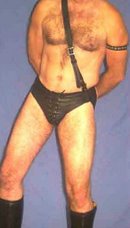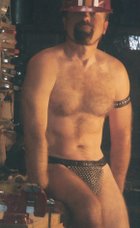See if you agree with the following article:
Gay themes brought debate to TV
By Rob Thomas
Visibly taken aback by the election results of the night before, Jon Stewart of Comedy Central's "The Daily Show" was struggling on Nov. 3, 2004, to figure out the key reason that President Bush won re-election. The reason he came up with was not tax cuts or abortion rights, or even national security.
He came up with "Will & Grace."
Stewart was using the popular and groundbreaking NBC comedy, which just ended its Emmy-winning run last month, as shorthand for gay rights issues. After all, in the 2004 election, 11 states had amendments opposing same-sex marriage on the ballot, including the deciding state of Ohio, and many observers felt these amendments brought cultural conservatives to the polls and tipped the scales in Bush's favor.
When Ron Becker, assistant professor of communications at Miami University of Ohio, saw Stewart mention "Will & Grace," he saw he had been given the opening quotation for his new book "Gay TV and Straight America." A single half-hour TV show summed up the key cultural issue that a presidential election had turned on.
UW alumnus Ron Becker will speak at Borders West on Thursday at 7 p.m.
Becker's book, published in February by Rutgers University Press, looks back on how the television landscape changed in the 1990s to become friendlier to both gay characters and gay issues. He'll read from and talk about the book at 7 p.m. Thursday at Borders West, 3750 University Ave.
The book, based on the dissertation Becker wrote while as a student at the University of Wisconsin-Madison, surveys gay themes on a broad range of shows, everything from the expected programs like "Will & Grace" and "Ellen" to "The Commish" and "Seinfeld."
Becker says his goal was not to document the prevalence of gay characters, but to chronicle gay themes on shows even when there were no gay characters present, and to show how they reflected what was happening in both gay and straight America.
"It's about sexual identity even if there are no gay or lesbian characters," Becker says. "The classic example is the 'Seinfeld' episode where Jerry and George are mistaken for being gay. All through the episode, they're saying 'We're not gay, not that there's anything wrong with that.' The whole episode is about the politics of sexual identity."
The "Seinfeld" episode illustrates a recurring theme of straight people having to address their own sexual identity as being separate from that of gay people. It's something that characters on television didn't have to deal with before the 1990s (because there were hardly any gay people on television) but became fodder for both drama and comedy during the decade.
Becker deems these themes "straight panic," and what was happening on television mirrored what straight America was dealing with in the 1990s as gays entered the mainstream.
"One of the ways that heterosexuality and homosexuality are related is that heterosexuality, as 'normal,' is defined and established by its 'abnormal' other," Becker says. "So what happens when gays demand to be normal?"
If it seems as if comedies tended to address gay themes more than dramas in the 1990s, Becker says that the anxiety brought on by "straight panic" and other aspects of sexual politics did make good fodder for comedy writers. But he also notes that situation comedies were just much more prevalent than dramas in the 1990s, and in fact both genres addressed gay themes at similar rates.
"Gay TV" looks at several common ways straight TV characters became involved with gay themes, from the "helpful heterosexual" who might use their position to help a gay friend, to the "homosexual heterosexual" who gets mistaken by others for gay.
Becker points to an episode of "Homicide: Life on the Street" as a clever twist on this theme, where the detectives investigate the murder of a man outside a gay bar, an apparent hate crime. In fact, even though the man was murdered because the killer thought he was gay, he was straight.
N ot surprisingly, the networks didn't throw open the doors and allow gay characters and themes onto television motivated primarily by altruistic or socially progressive reasons, Becker says.
The reason was simple: money.
In the 1990s, television networks chased relentlessly after a coveted young, big-city demographic with shows like "Friends" and "NYPD Blue." The thinking was that these viewers would be lucrative for potential advertisers, and would be attracted to shows that reflected their hip and tolerant worldview. In fact, in putting gay characters on their shows, the networks were more interested in attracting tolerant straight viewers than gay viewers themselves.
"I argue in the book that the networks became obsessed with 18- to 49-year-olds, and 18- to 34-year-olds especially," Becker says. "They perceived those people as being urban and hip and edgy, and that's why you saw a whole bunch of programs like 'NYPD Blue' pushing boundaries."
In that climate, viewers who might object to seeing such shows on television were largely ignored by the networks, Becker says. That changed in this decade; cultural conservatives got much more organized, and incidents like the 2004 Super Bowl halftime show controversy drew attention to the notion of "decent" vs. "indecent" television.
Today, Becker sees more shows with gay themes that seem to be aimed at gay viewers in a way that they weren't a decade ago.
"'Queer Eye for the Straight Guy' was clearly made for an 18-to-49-year-old female audience in mind," Becker says. "But they also made it with a gay audience in mind. Whereas with 'Will & Grace,' they said maybe some gay people will watch. But it was made with that young, urban audience in mind."
Becker says it's always tricky to try to draw connections between what people watch on television and what they think in their daily lives. But, as someone who remembers growing up in the 1980s and seeing hardly any gay characters like himself on television, he thinks the emergence of those characters in the 1990s was a positive force, fostering tolerance and acceptance of gays in the straight community.
"Their more open and accepting attitudes did make it more palatable," he says. "It had, I would argue, a normalizing effect."
E-mail: rthomas@madison.com
Published: June 14, 2006
Big Daddy Day Hugs to all my Blog Buds.
Subscribe to:
Post Comments (Atom)











3 comments:
Like everything there is good publicity and there is bad... I'm personally waiting for the media to move beyond the makeover shows and the miserable straight chick's "bestest gay friend" buddy comedy shows... Don't get me wrong, I know that piece of life exists int he GLBT world and I support it.
What I want to see are shows that incorporate mainstream gay people and whatever culture that brings with them. That means the people who aren't the stereotypical "gay" images... I want to see big bears, butch muscleboys, femme lesbians, leathergals, leatherboys and whatever else... but I want to see them as they are in real life - normal, feeling and not absurd caricatures (even though some might think their appearances already lend themselves to that fate)...
This is a tall order and not one I expect to see anytime soon, well except for on channels like Logo, but even that will do. :-)
I agree with TOS, in fact I'll go a step further and say that I think a show about those 'gay' images, the bears, muscleboys, femme lesbians etc. etc. could bring a huge draw to advertisers if a show was put together encapsulating all those ideas, plus your token straight couple who find themselves in the middle (we are talking about marketability here, they breeders have to see someone they can identify with).
Hi Buff!
To you and every one who reads this, please help Kelly in his challenge.
Rambling along in life
Thanks.
Post a Comment